Tags
1st Duke of Monmouth, Duke of York, English Civil War, Illegitimate, James Scott, King Charles II of England, King James II of England, Lucy Walter, Rebellion, Royal Bastard
James Scott, 1st Duke of Monmouth, 1st Duke of Buccleuch (April 9, 1649 – July 15, 1685) was a Dutch-born English nobleman. Originally called James Crofts or James Fitzroy, he was born in Rotterdam in the Netherlands, the eldest illegitimate son of Charles II of England, Scotland, and Ireland with mistress Lucy Walter
During the summer of 1648, Charles, Prince of Wales was in exile as the English Civil War was being played out. The Prince of Wales captivated by Lucy Walter, who was at The Hague for a short while about this time. He was only eighteen, and she is often spoken of as his first mistress, but they may have had a tryst as early as 1646.
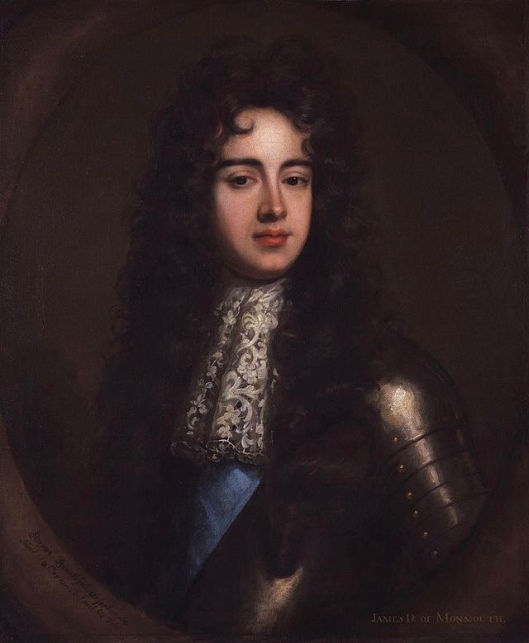
James Scott, 1st Duke of Monmouth, 1st Duke of Buccleuch
Charles moved to The Hague during 1648, during the Second English Civil War, where his sister Mary and his brother-in-law William II, Prince of Orange, were providing more support to his father Charles I‘s cause than his French relations.
James was born in Rotterdam in the Netherlands, then spent his early years in Schiedam.
There is some question to whether or not Prince Charles was the father of James Scott. Research by Hugh Noel Williams suggests that Charles had not arrived at The Hague until the middle of September 1648 – seven months before the child’s birth, but that he had met Lucy in July. Some voices later whispered that in the summer of 1648 Lucy had been the mistress of Colonel Robert Sidney, a younger son of the Earl of Leicester. When the child grew to manhood, those loyal to the Duke of York (whom the exclusionists wished to replace as heir to the throne) publicly put about the story that they saw a semblance to Sidney.

Charles II, King of England, Scotland and Ireland. Father of The Duke of Monmouth.
These voices may have been encouraged by the Duke of York himself, brother of King Charles II, who was afraid of any of the acknowledged fourteen royal bastards’ possible claims to the throne, Charles having no legitimate surviving children. In 2012, a DNA test of Monmouth’s patrilineal descendant the 10th Duke of Buccleuch showed that he shared the same Y chromosome as a distant Stuart cousin; this is evidence that Charles II was indeed Monmouth’s father.

Lucy Walter, mistress of King Charles II and Mother of the Duke of Monmouth.
As an illegitimate son, Monmouth was ineligible to succeed to the English or Scottish thrones, unless he could prove rumours that his parents had married secretly. Monmouth came to maintain that his parents were married and that he possessed evidence of their marriage, but he never produced it. Charles II, as King, later testified in writing to his Council that he had never been married to anyone except his queen, Catherine of Braganza.
On February 14, 1663, at the age of 13, shortly after having been brought to England, James was created Duke of Monmouth, with the subsidiary titles of Earl of Doncaster and Baron Scott of Tynedale, all three in the Peerage of England, and on 28 March 1663 he was appointed a Knight of the Garter.
On April 20, 1663, just days after his 14th birthday, he was married to the heiress Anne Scott, 4th Countess of Buccleuch. James took his wife’s surname upon marriage. The day after his marriage, the couple were made Duke and Duchess of Buccleuch, Earl and Countess of Dalkeith, and Lord and Lady Scott of Whitchester and Eskdale in the Peerage of Scotland. Monmouth, as he became known, was popular, particularly for his Protestantism, whereas the official heir presumptive to the throne, the King’s brother James, Duke of York, had openly converted to Roman Catholicism.
In 1665, at the age of 16, Monmouth served in the English fleet under his uncle, Prince James, the Duke of York in the Second Anglo-Dutch War. In June 1666, he returned to England to become captain of a troop of cavalry. On September 16, 1668 he was made colonel of the His Majesty’s Own Troop of Horse Guards. He acquired Moor Park in Hertfordshire in April 1670.
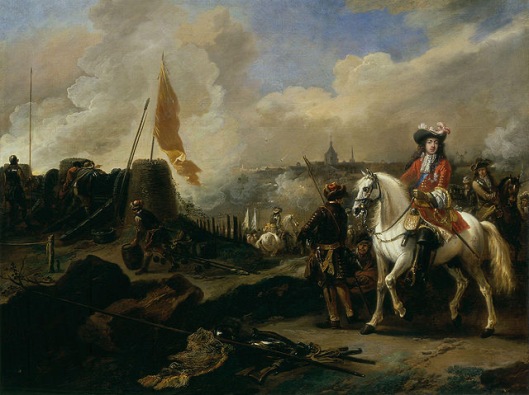
James Scott, Duke of Monmouth, commanding the English against the Dutch in 1672, by Jan Wyck
In June of this 1679. It was at about this time that he was first seriously proposed as the rightful heir to the Crown, despite the obvious problem of his illegitimacy, and his father’s refusal to acknowledge that he had married Lucy Walter. Monmouth may have come to sincerely believe that his parents had been married.
Rebellion
As his popularity with the masses increased, Monmouth was obliged to go into exile in the Dutch United Provinces in September 1679. Following the discovery of the so-called Rye House Plot in 1683, which aimed to assassinate both Charles II and his brother James, Monmouth, who had been encouraged by his supporters to assert his right to the throne, was identified as a conspirator. On King Charles II’s death in February 1685, Monmouth led the Monmouth Rebellion, landing with three ships at Lyme Regis in Dorset in early June 1685, in an attempt to take the throne from his uncle, James II-VII.
He published a “Declaration for the defence and vindication of the protestant religion and of the laws, rights and privileges of England from the invasion made upon them, and for delivering the Kingdom from the usurpation and tyranny of us by the name of James, Duke of York”: King James II and VII responded to this by issuing an order for the publishers and distributors of the paper to be arrested.
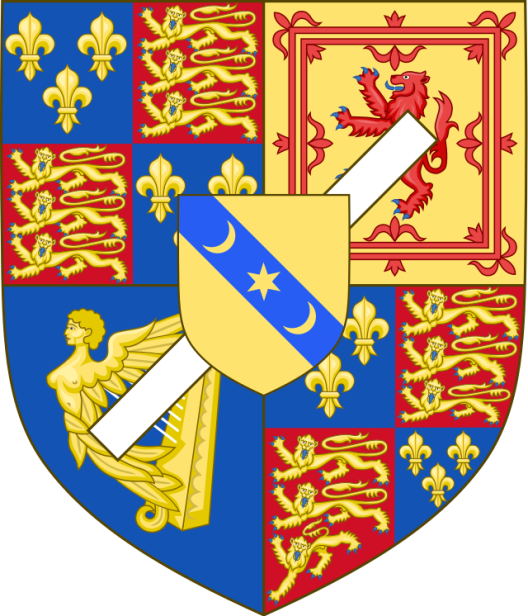
Coat of Arms of the 1st Duke of Monmouth and Buccleuch: The royal arms of King Charles II differenced with a baton sinister argent overall an inescutcheon of pretence of Scott (Or, on a bend azure a mullet of six points between two crescents of the field).
Monmouth declared himself as the rightful King at various places along the route including Axminster, Chard, Ilminster and Taunton. The two armies met at the Battle of Sedgemoor on 6 July 1685, the last clear-cut pitched battle on open ground between two military forces fought on English soil: Monmouth’s makeshift force could not compete with the regular army, and was soundly defeated.
Capture
Following the battle a reward of £5,000 was offered for his capture. On 8 July 1685, Monmouth was captured and arrested near Ringwood in Hampshire,
Following Monmouth’s capture, Parliament passed an Act of Attainder, 1 Ja. II c. 2:
Treason. ¶Whereas James Duke of Monmouth has in an hostile Manner Invaded this Kingdome and is now in open Rebellion Levying Warr against the King contrary to the Duty of his Allegiance, Bee it enacted by the Kings most Excellent Majestie by and with the Advice and Consent of the Lords Spirituall and Temporall and Commons in this Parlyament assembled and by the Authoritie of the same, That the said James Duke of Monmouth Stand and be Convicted and Attainted of High-Treason and that he suffer Paines of Death and Incurr all Forfeitures as a Traitor Convicted and Attainted of High Treason.
The King took the unusual step of allowing his nephew an audience, despite having no intention of extending a pardon to him, thus breaking with a longstanding tradition that the King would give an audience only when he intended to show clemency. The prisoner unsuccessfully implored his mercy, and even offered to convert to Catholicism, but to no avail. The King, disgusted by his abject behaviour, coldly told him to prepare to die, and later remarked that Monmouth “did not behave as well as I expected”. Numerous pleas for mercy were addressed to the King, but he ignored them all, even that of his sister-in-law, the Dowager Queen Catherine.
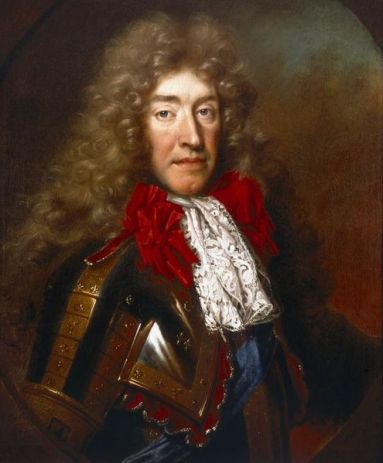
James II, King of England, Scotland and Ireland. Uncle of The Duke of Monmouth.
Monmouth was beheaded by Jack Ketch on July 15, 1685, on Tower Hill. Shortly beforehand, Bishops Turner of Ely and Ken of Bath and Wells visited the Duke to prepare him for eternity, but withheld the Eucharist, for the condemned man refused to acknowledge that either his rebellion or his relationship with Lady Wentworth had been sinful.
It is said that before laying his head on the block, Monmouth specifically bade Ketch finish him at one blow, saying he had mauled others before. Disconcerted, Ketch did indeed inflict multiple blows with his axe, the prisoner rising up reproachfully the while – a ghastly sight that shocked the witnesses, drawing forth execrations and groans. Some say a knife was at last employed to sever the head from the twitching body. Sources vary; some claim eight blows, the official Tower of London fact sheet says it took five blows, while Charles Spencer, in his book Blenheim, puts it at seven.
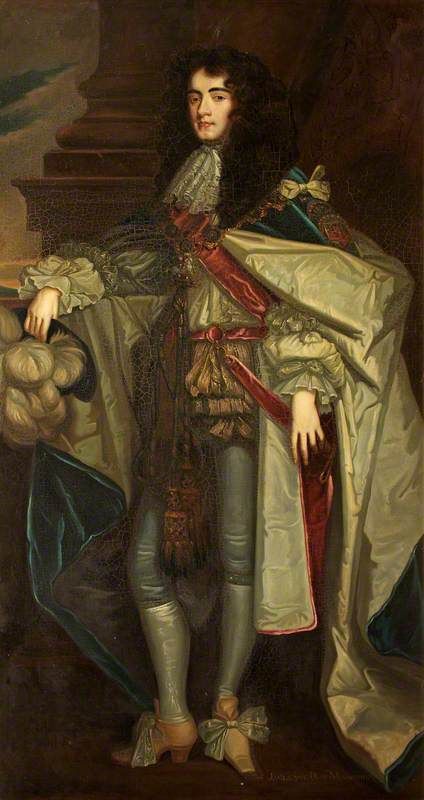
James Scott, 1st Duke of Monmouth, 1st Duke of Buccleuch
Monmouth was buried in the Church of St Peter ad Vincula in the Tower of London. His Dukedom was forfeited, but his subsidiary titles, Earl of Doncaster and Baron Scott of Tindale, were restored by King George II on March 23, 1743 to his grandson Francis Scott, 2nd Duke of Buccleuch (1695–1751).

I need help and advice. It may be nothing but I’m stumbling around in a plantageanet world of which I believe I am one but no nothing.
Would anyone care to consider assisting me?
I think that I have direct lineage to the Howard Family and the Henry Kings.